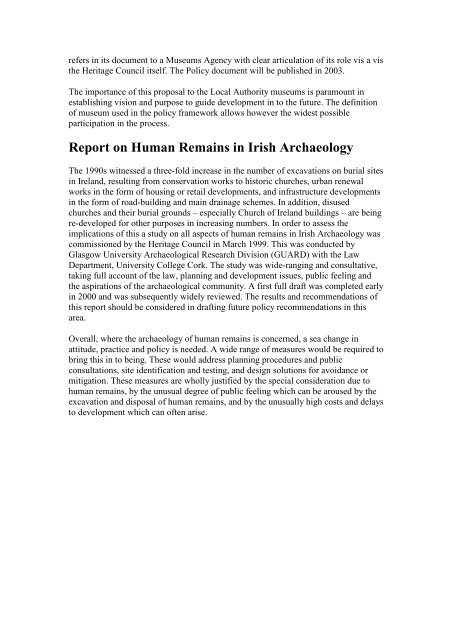The Heritage Council Annual Report 2002
The Heritage Council Annual Report 2002
The Heritage Council Annual Report 2002
You also want an ePaper? Increase the reach of your titles
YUMPU automatically turns print PDFs into web optimized ePapers that Google loves.
efers in its document to a Museums Agency with clear articulation of its role vis a vis<br />
the <strong>Heritage</strong> <strong>Council</strong> itself. <strong>The</strong> Policy document will be published in 2003.<br />
<strong>The</strong> importance of this proposal to the Local Authority museums is paramount in<br />
establishing vision and purpose to guide development in to the future. <strong>The</strong> definition<br />
of museum used in the policy framework allows however the widest possible<br />
participation in the process.<br />
<strong>Report</strong> on Human Remains in Irish Archaeology<br />
<strong>The</strong> 1990s witnessed a three-fold increase in the number of excavations on burial sites<br />
in Ireland, resulting from conservation works to historic churches, urban renewal<br />
works in the form of housing or retail developments, and infrastructure developments<br />
in the form of road-building and main drainage schemes. In addition, disused<br />
churches and their burial grounds – especially Church of Ireland buildings – are being<br />
re-developed for other purposes in increasing numbers. In order to assess the<br />
implications of this a study on all aspects of human remains in Irish Archaeology was<br />
commissioned by the <strong>Heritage</strong> <strong>Council</strong> in March 1999. This was conducted by<br />
Glasgow University Archaeological Research Division (GUARD) with the Law<br />
Department, University College Cork. <strong>The</strong> study was wide-ranging and consultative,<br />
taking full account of the law, planning and development issues, public feeling and<br />
the aspirations of the archaeological community. A first full draft was completed early<br />
in 2000 and was subsequently widely reviewed. <strong>The</strong> results and recommendations of<br />
this report should be considered in drafting future policy recommendations in this<br />
area.<br />
Overall, where the archaeology of human remains is concerned, a sea change in<br />
attitude, practice and policy is needed. A wide range of measures would be required to<br />
bring this in to being. <strong>The</strong>se would address planning procedures and public<br />
consultations, site identification and testing, and design solutions for avoidance or<br />
mitigation. <strong>The</strong>se measures are wholly justified by the special consideration due to<br />
human remains, by the unusual degree of public feeling which can be aroused by the<br />
excavation and disposal of human remains, and by the unusually high costs and delays<br />
to development which can often arise.
















